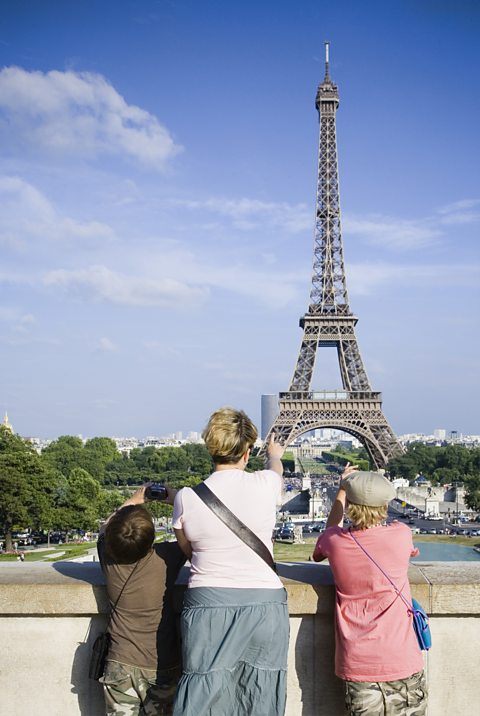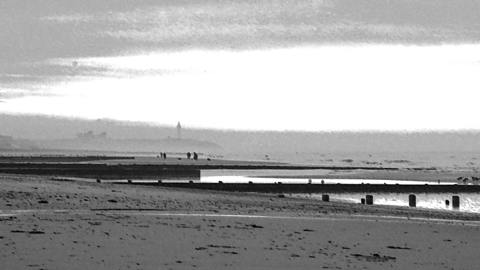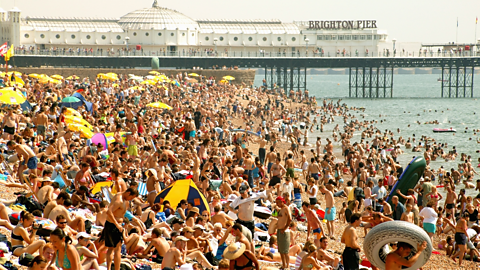What do you know?
What is tourism?
Tourism is where people spend time away from home for pleasure.
Key points
- People choose to go on holiday both abroad and in their own country.
- The tourism industry has grown over time and is now an important industry in many countries.
- Tourism happens in cycles with destinations rising and falling in popularity.
What is tourism?
Tourism is when people travel away from home for pleasure. Tourism is an important industryThe process of making money and any form of employment that makes money. Types of industry include primary industry such as farming, secondary industry such as manufacturing, and tertiary industry such as hospitality and tourism. providing jobs and income to millions of people around the world and vital income for many countries. Low-income countries (LICs) may rely on tourism as one of their major sources of income. In 2013 the UK tourism industry was worth ÂŁ126.9 billion, which made up 9% of the UK's Gross Domestic Product - GDPThe total value of goods produced and services provided in a country during one year. and employed 173,000 people.
There are two types of tourism:
- international tourism – where tourists visit other countries
- domestic tourism – where tourists visit places in their own country
The most popular countries for international tourists to visit are France, Spain, USA, China, Italy, Turkey, Mexico and the United Kingdom.

People are attracted to visit different places for a number of reasons.
- They may travel to cities for the history, culture or famous landmarks. For example, many people travel to Paris in France to see the Eiffel Tower.
- People may also be attracted by the physical environmentThe natural surroundings.. For example, coastal regions are very popular destinations for tourists as people may wish to sunbathe or take part in water sports. Margate on the Kent coast in south east England has had a revival as a popular seaside resort with the reopening of the Dreamland amusement park in 2015.
- The climate plays a big part in a decision to travel to different places. Mediterranean countries such as Spain, Greece and Turkey, with high temperatures and low rainfall in the summer, are popular tourist destinations.
- Some people now travel looking for adventure, and extreme tourism is becoming more popular. This might include travelling to unusual and adventurous places or taking part in exciting physical activities.

Question
Why is tourism important to many countries?
Tourism is an important industry providing jobs and income to millions of people around the world.
Test your knowledge
The growth of tourism
Since the 1950s tourism has become more and more popular. This is due to a number of reasons:
- advances in technology meaning that travel is now easier, quicker and more affordable
- the growth of the internet means it is easier than ever before to book holidays
- improvements in workers’ rightsWorkers are entitled to certain rights, such as getting paid the National Minimum Wage and paid holidays. means that paid holidays for employees, makes it easier to take time off
- more disposable incomeThe money you have left after you pay your taxes, pay for essentials such as food and bills to spend on yourself and your family., due to changes such as smaller average family size and more families with two incomes, means some people have more money to spend on themselves
- mass mediaCommunication that reaches a large audience such as national TV, newspapers, radio and social media. such as TV, magazines, advertising and the internet, has brought different destinations to our attention and led to a greater desire to travel
Question
How have advances in technology helped to increase the number of tourists?
Advances in technology mean that travel is now easier, quicker and more affordable.
Patterns in tourism
Butler's tourism life cycle model
A model is a simplification of the real world used to better understand reality.
All tourist destinations follow a pattern in terms of popularity. Professor Richard Butler suggested a model for the life cycle of a tourist destination which has a number of stages:
Step 1 – tourists start to discover a resortA place people visit for relaxation or recreation usually including accommodation, entertainment and places to eat. . At this point not many people know about the resort and there are only a few visitors.
Step 2 – the word spreads about the resort and businesses begin to open up services to cater for the tourists, such as hotels and restaurants. At this point the numbers rise until the resort becomes very busy.
Step 3 - At this point people may stop visiting as the resort has lost its appeal and become over-crowded.
Step 4 - the area either goes into declineA decrease. or rejuvenatesTo give new life to something. itself by investing in improvements. Meanwhile new areas are discovered and the cycle begins again.
Case study: The rise and fall and rise of Blackpool

Image caption, The fresh sea air and long beach first attracted visitors to Blackpool.
Image caption, In the early 19th Century, Blackpool’s tourist industry began to grow with the building of hotels and attractions such as the Winter Gardens
Image caption, A rise in cheap package holidays abroad left Blackpool in a state of decline.
Image caption, A ÂŁ300 million regeneration project launched in 2000 in the hope of stopping the decline.
1 of 4
Test your knowledge
Play the Planet Planners game! gamePlay the Planet Planners game!
Make decisions for the planet in this KS3 geography game.

More on Tourism
Find out more by working through a topic
- count2 of 2
